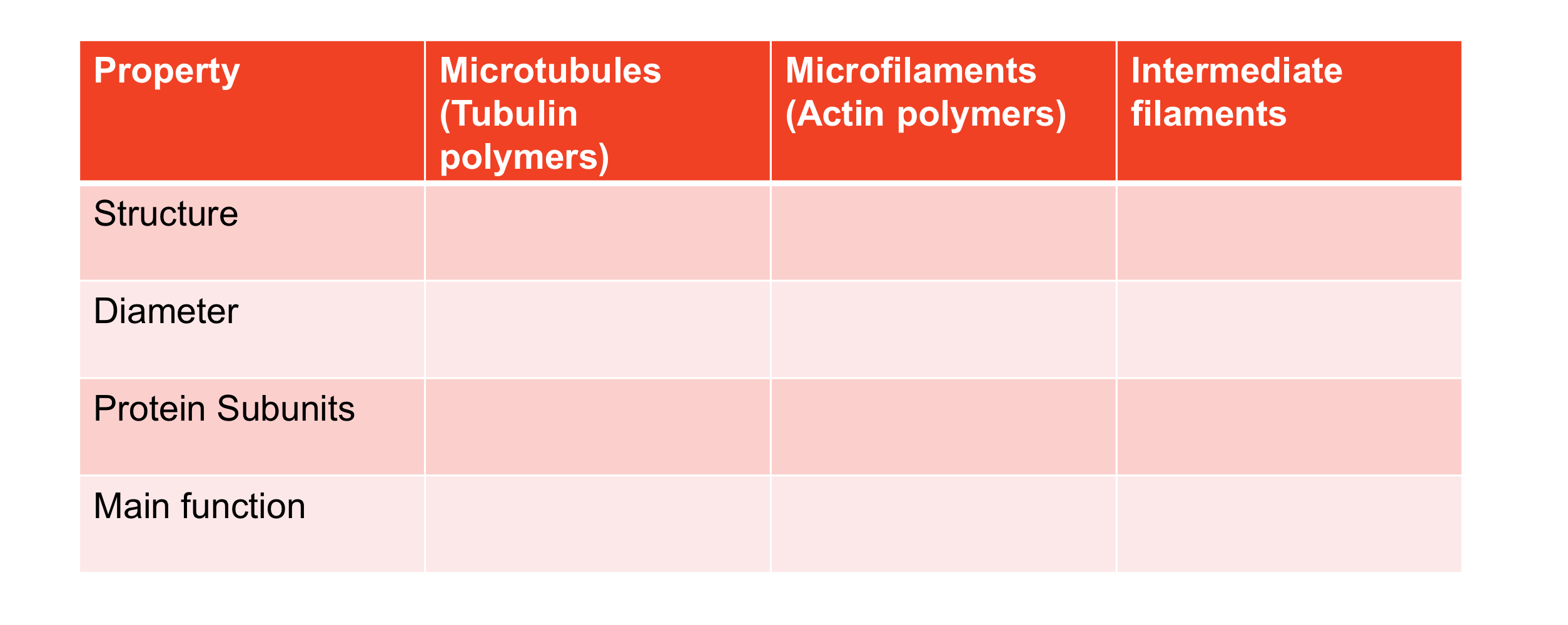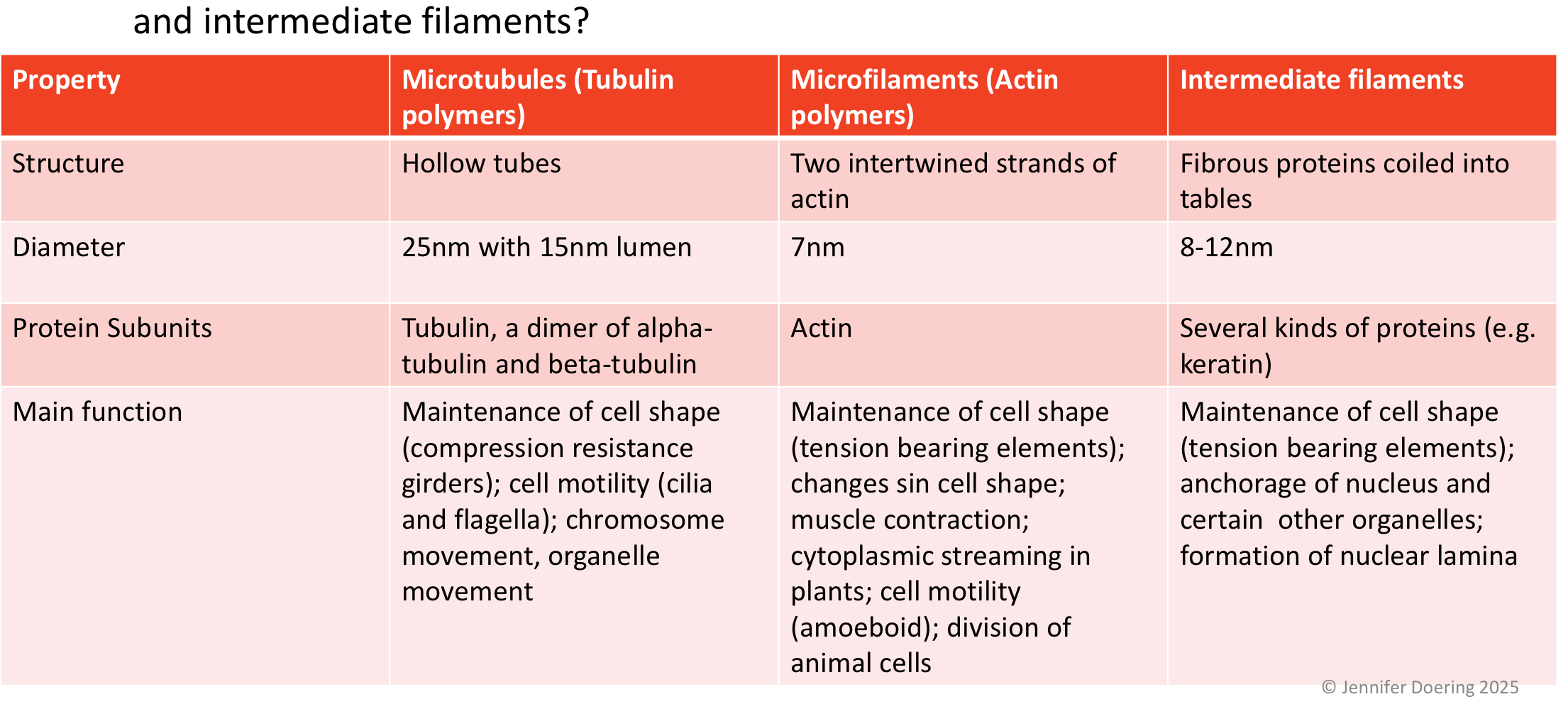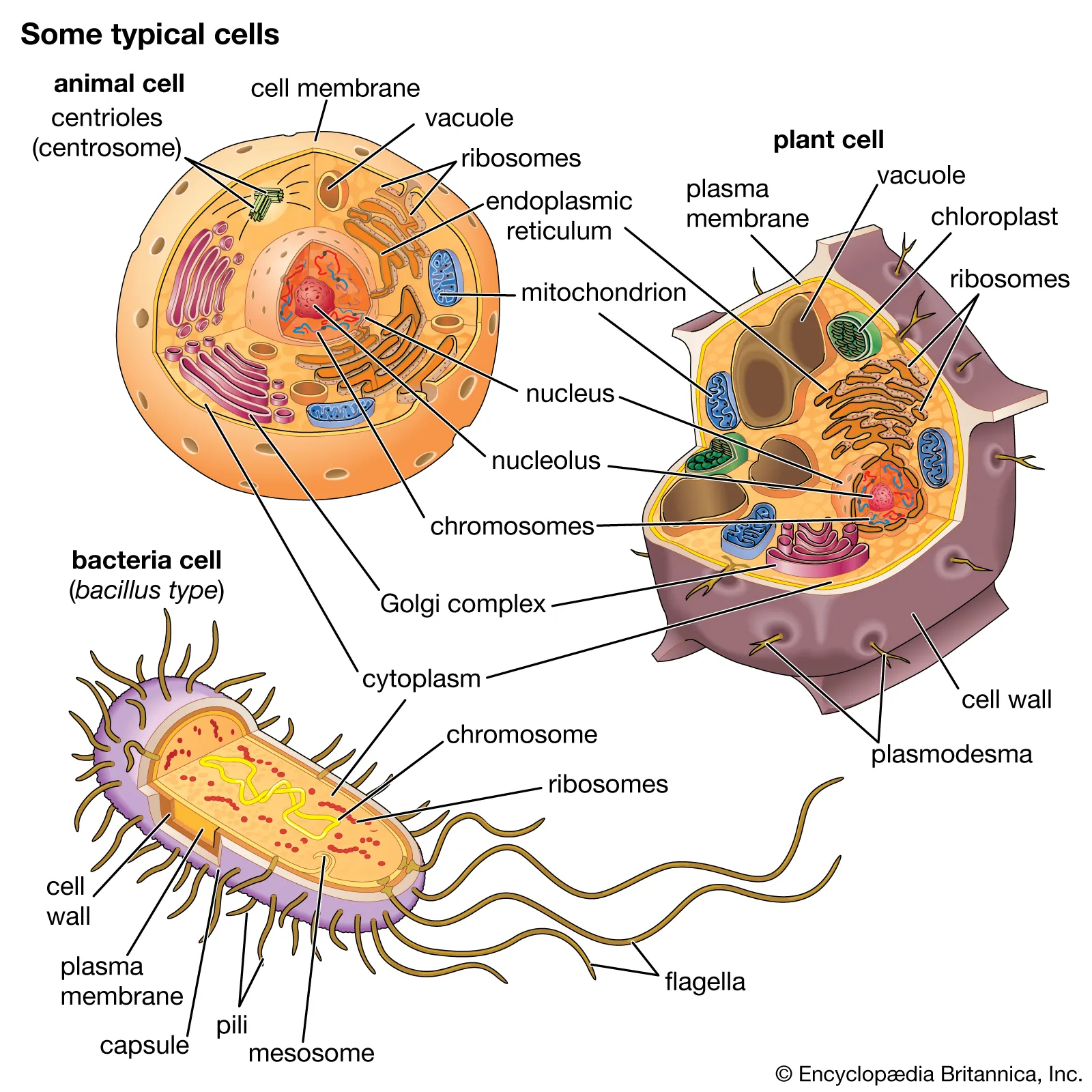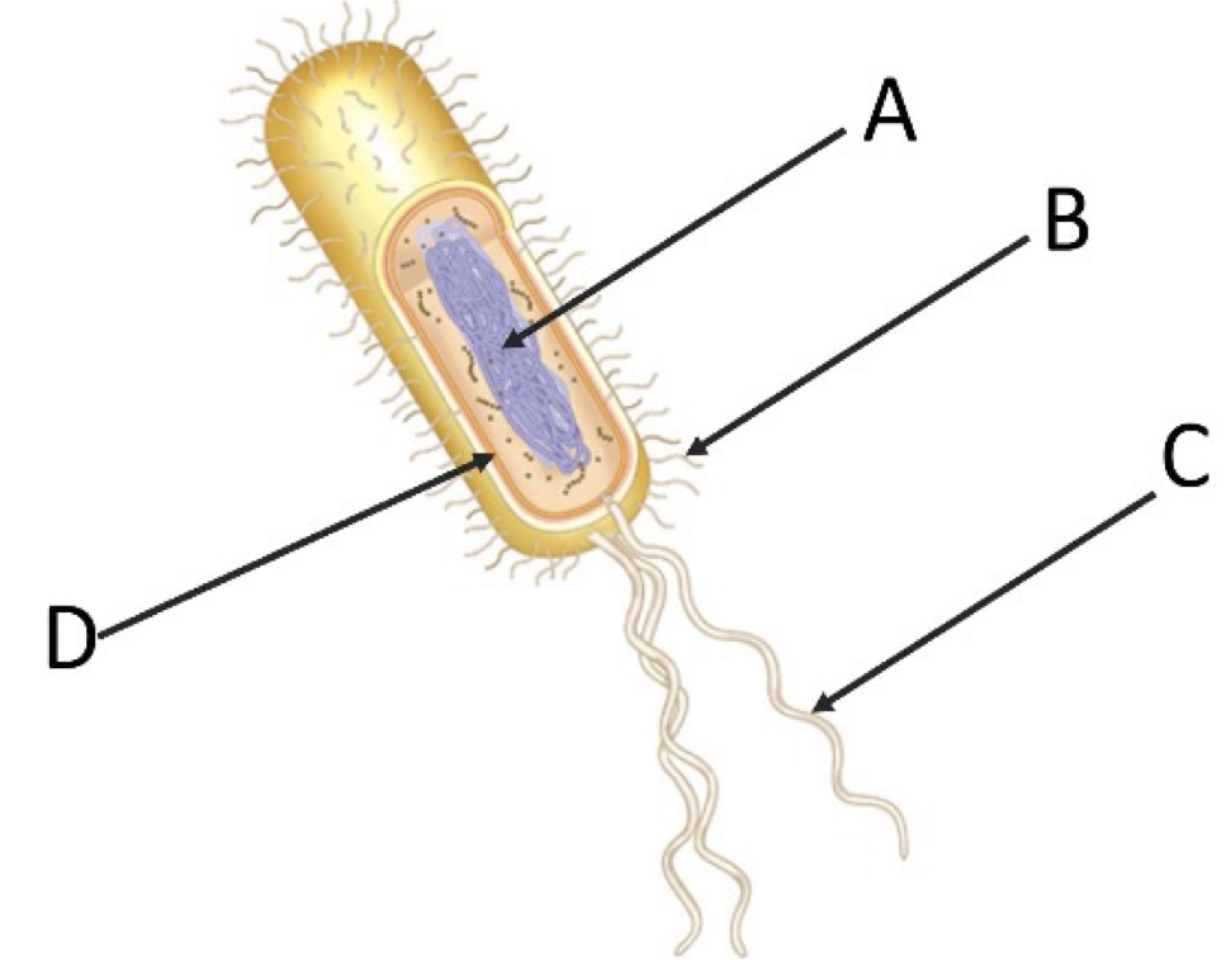BIOL 1020- Lectures 8, 9 , 10: Cell Structure
1/57
There's no tags or description
Looks like no tags are added yet.
Name | Mastery | Learn | Test | Matching | Spaced |
|---|
No study sessions yet.
58 Terms
Describe the limitations to cell size based on the surface area to volume ratio
The surface area-to-volume ratio imposes a fundamental limit on cell size because as cells grow, their volume outpaces their surface area, making nutrient and waste exchange insufficient to support the cell’s metabolic needs
Compare and contrast the structure of bacterial and eukaryotic cells
Bacterial cells:
no nucleus
no internal membrane-bound organelles
single-celled
Eukaryotic cells:
possess a nucleus
many membrane-bound organelles
single-celled
Where is DNA kept in prokaryotes?
Nucleoid (not bound by a membrane)
What protects prokaryotes?
Cell wall outside their plasma membrane
made of peptidoglycan
Glycocalyx: a waxy protective coating made up of glycoproteins and glycolipids
Where is DNA kept in Eukaryotes?
DNA is centralized in the nucleus (membrane bounded by the nuclear envelope)
What protects and supports Eukaryotes?
Some have cell walls made up of cellulose (plants) and chitin (fungi)
They have cytoskeleton for structure and support
Cytosol vs Cytoplasm
Cytosol: the part of the cytoplasm that is not held by any organellee
Cytoplasm: the material (protoplasm) within a living cell, excluding the nucleus (ie. the spaces and compartments between the plasma membrane and nuclear envelope)
What is in the cytoplasm of eukaryotes?
Ribosomes for protein synthesis via translation
Membrane bound organelles
Explain the endomembrane theory and the evolution of eukaryotes
The origin of eukaryotes came from a heterotrophic prokaryotic cell
The plasma membrane of a prokaryotic linage began invaginating (folding inwards) intoo the cytoplasm about 2 billion years ago
The invaginated membranes eventually separated from the plasma membrane
it surrounded the DNA to form a nucleus and became the endomembrane system of the eukaryotic cell
Describe the structure and function of cellular organelles of the endomembrane system
The endomembrane system drives cell processes
nuclear envelope
endoplasmic reticulum
golgi apparatus
lysosomes
vesicles and vacuoles
plasma membrane
What are some of the functions of the Endomembrane System?
protein synthesis (for both proteins staying in the cell or being exported)
protein transport (into membrane bound organelles or out of the cell
metabolism
movement of lipids
detoxifying the cell
Endoplasmic Reticulum (Factory)
Composed of a rough and smooth area
Rough ER
studded with ribosomes
continuous with the nuclear envelope
Produces glycoproteins (proteins with covalently bonded carbs)
separates and transports proteins via transport vesicles
produces phospholipids and other proteins
Smooth ER
Lacks ribosomes
Produces lipids (oils, steroids, phospholipids [main site])
detoxifies the cell by adding -OH to drugs which → to liver cells
Stores calcium ions to trigger muscle cell contractiono
Golgi Apparatus (Sorting)
series of flattened sacs - sisternae
cis side faces RER (younger) → recieving end
trans side points outwards towards the rest of the cell (older) → shipping end
Vesicles bring material from the RER to the cis face, fusing with the golgi membrane
Materials are modified as they pass through (postal codes)
Vesicles pinch off of the trans face and head to their final destination/outside the cell
Lysosome (digest and recycle)
membranous sac of hydrolytic enzymes
can break down macromolecules into monomers
acidic interior
when lysed, contents aren’t digested because the pH is too high for enzymee
partakes in intracellular digestion
Define the two types of intracellular digestion
Phagocytosis:
occurs between amoebas and other unicellular eukaryotes
food vacuole merges with a lysosome
digestive enzymes break down food molecules into monomers
Macrophages (WBC) use this process to kill bacteria and other invaders
Autophagy:
damaged organelles get surrounded by a double membrane
merges with a lysosome which digests the materials with hydrolytic enzymes
monomers and molecules are recycled by the cell
Vacuole
Large vesicles made from RER and golgi
Food and digestive vacuoles
Contractile vacuoles
pump out excess water from freshwater single celled organisms
Plant vacuoles
storage for small molecules
large central vacuole: contains inorganic ions and swells up due to osmosis
pushes on cell wall and provides turgor pressure
How do proteins know where to go?
Proteins have “built in postal codes” within their amino acid sequence, which get recognized by otheer proteins and direct the new proteins to their destination
Hydrophobic a.a in a specific order → endomembrane signalling sequences
Charged a.a in a specific order → mitochondrial signal sequences
No signalling sequence a.a. are destined for cytosol
Mitochondria
in most eukaryotic cells
site of cellular respiration
contains two membranes
intermembrane space in between
Inner membrane folded to make cristae which encloses the mitochondrial matrix
contains DNA and ribosomes
Chloroplast
type of plastid (closely related plant organelles such as amyloplasts and chromoplasts)
only in plants in algae
absorbs energy from photons
site of photosynthesis
contains two membranes
Intermembrane space in betweeen
inner membrane folded to make thylakoids which are stacked to form grana
contains DNA and ribosomes in the stroma
space between thee thylakoid space and inner membrane
contains chlorophyll (green)
Define heterotrophs, autotrophs, anaerobes, aerobes
Heterotrophs: organisms that obtain their energy through consuming other material
Autotrophs: organisms that obtain their energy themselves
Anaerobes: organisms that can’t survive in O2, and can’t use O2 to extract energy from molecules via aerobic respiratioon
Aerobes: organisms that can survive in O2 and can use O2 to extract energy from molecules via aerobic respiration
Explain the endosymbiont theory and the evolution mitochondria and chloroplasts
A eukaryotic cell engulfed an aerobic heterotrophic prokaryotic cell that could use oxygen
the prokaryote was retained an become the mitochondria
became an endosymbiont: a cell living inside another cell in a beneficial relationship
This process occurred again in photosynthetic organisms:
A eukaryotic cell with mitochondria engulfed an autotrophic prokaryote could do photosynthesis
Eventually became the chloroplast
Evidence to support;
Mitochondria and Chloroplasts are double membraned
contain their own set of DNA and ribosomes
Autonomous organelles (able to grow and reproduce in the cell
Peroxisomes (detox)
a specialized metabolic compartment bounded by a single membranee
contains enzymes that remove hydrogen atoms from substances and transfers it to oxygen
produces hydrogen perioxide — toxic but peroxisomes have the enzymes to turn it into wateer
Can be used for a variety of reactions
break down fatty acids
detoxify alcohol in the liver
Plants have a specialized peroxisome calleed a glyoxysome
Cytoskeleton
network of fibres that extend throughout the cytoplasm
in both bacteria and eukaryotes
Eukaryotic cytoskeletons are composed of
microtubulees
microfilaments
intermediate fibree
The cytoskeleton is dynamic — constantly rearranging
structural support (esp. in animal cells which lack cell walls) - resist tensile (pulling) and compressive forces
movement
utilizes motor proteins to movee organelles and vesicles throughout thee cell on microtubule highways
cillia and flagella aree made from cytoskeletal proteins

Compare and contrast the structure and basic function(s) of the three cytoskeletal elements

Microtubules
hollow protein tubes made of tubulin
a dimer - made up of alpha and beta subunits
undergoes polymerization (growth) by adding tubulin dimers
undergoes depolymerization (dissassemble) by releasing tubulin dimeers to be recycled elsewhere
each end will add/release at different rates
resist compressive forces
organized by the centrosome
centriole: nine sets of triplet microtubules arranged in a ring
serves as highways for vesicle transport and in cell division
Flagella:
usually one per cell
longer than cilia
undulating motion (snake)
Cilia:
usually many per cell
short than flageella
wave back and forth
Large motor proteins are required to bend the flagella and cilia
made up of dyneins, which cross link between microtubulee doublets and have feet to walk (using ATP)
Microfilaments
thinnest cytoskeleton proteins
made up of actin, a globular protein
actin filaments are solid
can be branched to form structural networks
present in all eukaryotic cells
actin can be added/removed from filament chains dynamically
resist tension (pulling) forces and maintain cell shape
myosin (motor proteins) interact with actin filaments to do muscle contractions
Amoeboid movement (cell moving) is caused by actin polymerisation
cytosolic streaming in plant cells
Intermediate Fibres
animal specific fibres
really resistant to tensile forces
composed of other proteins depending on the type of intermediate filament (eg. keratin)
more permenant (don’t often reassemble dynamically)
Roles:
help maintain cell shape and integrity
maintain organelle shape and integrity
make up nuclear lamina
maintain organelle position within the cells
What is the extracellular matrix
stuff outside the cell
connects cells together into tissues
components of the ECM are made inside the cell and exportted outside via the EM system
Cell Wall
extracellular structures in plants
maintain cell shape and prevent uptake of excess water
thicker than plasma membrane
composed of cellulose
composed of a primary cell wall with a middle lamella (composed of pectins)
some cells have a secondary cell wall between the plasma membrane and primary wall
deposited in layers
Has pores called plasmodesmata to allow substances to travel through cell walls
Compare the cell walls of bacteria, fungi, and plants
Bacteria
Main component: peptidoglycan (polysaccharide chains cross-linked with peptides).
Provides shape and protection.
Can be Gram-positive (thick peptidoglycan layer) or Gram-negative (thin layer + outer membrane).
Fungi
Main component: chitin (a strong polysaccharide with nitrogen, also found in insect exoskeletons).
Provides rigidity and protection.
Also contains glucans and glycoproteins.
Plants
Main component: cellulose (long chains of glucose).
Primary cell wall: flexible, allows growth.
Secondary cell wall: thicker, more rigid (with lignin).
Name the four cellular junctions
Tight junctions
Anchoring junctions
Gap junctions
Plasmodesmata (plant specific)
Tight junctions
for the adhesion of cells
plasma membranes of adjacent cells are held together by specialized proteins
creates a seal to prevent leakage for extracellular fluid, ions, etc
Anchoring junctions
binding proteins
desmosomes form sheets of strongly connected cells
keratin anchors the desmosomes into the cytoplasm via cytoskeleton
Gap Junctions
for communication of cells
connects the cytosol of adjacent cells
kind of like pipes!
allows for fast passage for ions and signalling molecules to coordinate activity
a reason why our heart beats as one
Plasmodesmata
Plant specific gap junctions (for communication)
channels that connect adjacent walls and cytosol
water and small solutes can pass freely between cell walls via these channels
can adjust diameter to allow large molecules pass through
move along microfibres of the cytoskeleton
Diagram the linkage between the extracellular matrix and intercellular cytoskeleton
The extracellular matrix (ECM) links to the intercellular cytoskeleton via transmembrane proteins called integrins. Integrins act as receptors for ECM components like fibronectin and laminin. Intracellularly, the cytoplasmic tails of integrins bind to focal adhesion proteins, such as talin and vinculin, which then connect to actin filaments. This multi-protein complex forms a physical connection, transmitting mechanical forces and transmitting signals, thereby anchoring the cell and facilitating processes like migration.
Draw and label a typical bacterium, and plant and animal cell

What does the nucleus do?
Information central: the nucleus contains the LINEAR DNA, transcription of genes for an individual cell
surrounded by the nuclear envelope
a double membrane of lipids (each a lipid bilayer)
the inner membrane is lined by nuclear lamina, which helps the nucleus retain shape
the outer membrane is continuous with the rough ER
contains nuclear pores which regulate substances going in and out of the nucleus
What does the nucleolus do?
a prominent feature in a non-dividing nucleus: densely stained region adjoininig the chromatin
produces rRNA and assembles ribosomes using proteins from the cytoplasm
ribosome subunits are exported through the nuclear pores and assembled in the cytosol
ribosomes will then remain free floating or associate with the RER
Describe chromatin
wound up into chromatin (a complex of DNA + histone proteins)
Euchromatin: partially unwound DNA, accessible for DNA replication and transcription
Heterochromatin: fully wound DNA, inaccessible
Describe the nucleoid in prokaryotes
have circular DNA chromosome
contains all the genes essential for prokaryote survival
not associated with histones
contain plasmids: non-essential DNA that aid in cell function

Which of the following represents the nucleoid?
A.
B.
C.
D.
A.
iclicker question: what features do plant cells have that animal cells do not? select all that apply
1. Plasma membrane
cell wall
lysosome
large central vacuolee
chloroplast
2,4,5
cell wall,
large central vacuole
chloroplast
iclicker question: which of the following regarding thee eukaryotic nucleus is true
a. the DNA is packed into chromatin using actin proteins
b. euchromatin is compact and contains genes that are not actively transcribed
c. the nuclear lamina controls what goes into and out of the nuclear envelope
d. the nuclear envelope is continuous with the golgi complex
e. rRNA genes are actively transcribed in the nucleolus
a. wrong. histines, not actin
b. wrong. heterochromatin, not euchromatin
c. wrong. pore, not lamina
d. wrong. ER, not nuclear envelopee
e. correct.
iclicker question: which of these statements properly describes the endosymbiosis theory of the origin of mitochrondria?
a. an anaerobic heterotrophic eukaryotic cell engulfed an aerobic heterotrophic prokaryotic cell
b. an aerobic autotrophic prokarytoic cell engulfed an anaerobic heterotrophic eukaryotic cell
c. an aerobic heterotrophic eukaryotic cell engulfeed an aerobic autotrophiic prokaryotic cell
d. an anaerobic heterotrophic eukaryotic cell engulfed an anaerobic autotrophic prokaryotic cell
a. an anaerobic heterotrophic eukaryotic cell engulfed an aerobic heterotrophic prokaryotic cell
iclicker question: a cell produces a glycoprotein which functions outside of the cell. What is the proper order of organelles in which this protein will be made in and then pass through to get to the exterior of the cell?
a. nucleus, RER, secretory vesicle, outside
b. cytoplasm, lysosome, SER, outside
c. SER, secretory vesicle, golgi apparatus, outside
d. RER, golgi apparatus, secretory vesicle, outside
d. RER, golgi apparatus, secretory vesicle, outside
iclicker question: which of the following are used in communication?
a. tight junctions
b. anchoring junctions
c. desmosomes
d. plasmodesmata
d. plasmodesmata
Which of the following is not a specialized cell connection
a. tight junctions
b. anchoring junctions
c. gap junctions.
d. plasmodesmata
e. nuclear pores
e. nuclear pores
quiz questions